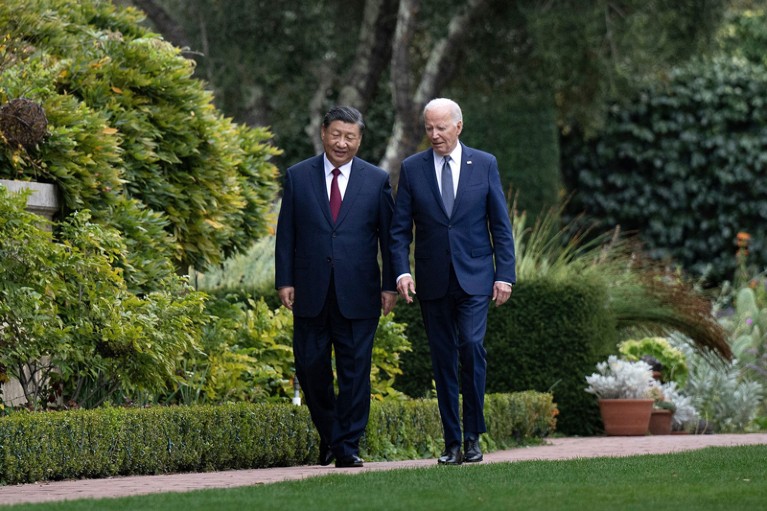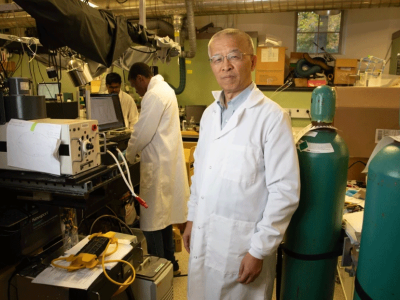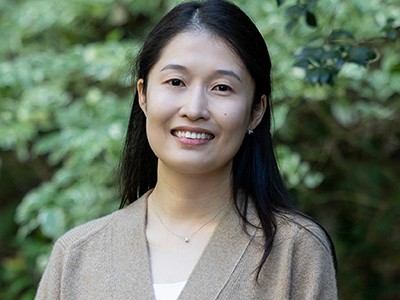At the end of August, the US–China Science and Technology Cooperation Agreement (STA) is set to lapse. This historic pact to support joint research has been renewed every five years since it was first signed in 1979, when the two nations normalized diplomatic relations. But in a heated election year and with only one bipartisan consensus in US politics — antagonism towards China — it is uncertain whether the STA will be renewed this time.
China–US research collaborations are in decline — this is bad news for everyone
In February, the STA was extended for another six months after an open-letter campaign — launched by physicists Steven Kivelson and Peter Michelson at Stanford University in California — called on US President Joe Biden to renew the agreement. The letter, which was signed by more than 1,000 researchers, including Nobel laureates, argued that the STA is a framework for open, fundamental research and that such research benefits the United States and the world.
Such research is a bedrock principle of scientific enterprise. In the United States it is protected under the National Security Decision Directive 189 (NSDD-189), issued by the administration of president Ronald Reagan in 1985 during the cold war and reaffirmed by president George W. Bush in 2001 after the terrorist attacks on 11 September. NSDD-189 establishes that the products of fundamental research should remain unrestricted to the maximum extent possible, promoting open and free communication of scientific findings. The directive is intended to support US leadership in science and technology and acknowledges that the sharing of fundamental scientific knowledge is rarely a security threat.
In the past decade, however, geopolitical dynamics have shifted, leading the US government to increasingly overlook this bedrock principle. US-based researchers who have conducted normal academic activities with their Chinese counterparts have been branded as spies. Agents of US Customs and Border Protection have interrogated scientists simply because of their Chinese backgrounds and their research disciplines. In 2023, Florida enacted a bill restricting the hiring of graduate students from a “country of concern”, mainly China, in state universities’ academic laboratories. In January this year, the US Congress attempted to resurrect the ‘China Initiative’, a programme set up by the US Department of Justice to prosecute perceived Chinese spies in US research and industry, even though the initial programme that was launched in 2018 was plagued with flaws and was shut down in 2022. In June, the US House of Representatives proposed a bill that would prohibit the Department of Defense from giving funding to any US university that has research collaborations with China.
China–US climate collaboration concerns as Xie and Kerry step down
Regrettably, these policy actions — poorly thought out in my view and tainted with racial profiling — are a sign of things to come. At a practical level, the era of close and unfettered collaborations between US and Chinese scientists and technologists has come to an end.
I think that scientists should now consider going beyond arguing for openness just for fundamental research and craft a pragmatic case for continuing bilateral collaborations in certain areas. More pragmatic narratives and an operational programme that fully addresses the national security imperatives while preserving some aspects of productive collaborations between the two countries are needed. Here, I propose some ideas for discussion.
Science and politics are interlinked
Three obstacles stand in the way of further scientific and technological collaborations between the United States and China.
First, rightly or wrongly, there is an anti-collaborative bias embedded in US government support for science. Federal government steps up funding for research and development (R&D) not during times of geopolitical amity but during spells of animosity. For example, the launch of the Soviet Union satellite Sputnik 1 in 1957 pushed the United States to make large investments in science and technology during the cold war.
Academic leaders and scholars (see go.nature.com/4cpzz53) in the United States have used this historical analogy to argue for more federal spending for R&D in the face of mounting geopolitical and economic challenges from China. But researchers should recognize an inherent disconnect when they call for more government support while simultaneously pressing for continued collaborations with China. Only the most acute geopolitical enmity can encourage the federal government to act, but that acute sense of rivalry also galvanizes opposition to collaborations with China, the country that motivated the ramping up of support for science in the first place.
Second, policymakers and the public do not differentiate between science and technology as sharply as many in the academic community do. After all, the public foots the bill for scientific research and has a right to expect tangible benefits from that investment and to not be harmed by it. The distinction between fundamental and applied research is extraordinarily difficult to register in the mind of the public and of their representatives, the politicians.
Advocates of US–China collaborations can be conflicted and selective on this issue. They have pointed to the intrinsic value of fundamental research as well as to the practical benefits for the US economy and society when scientific collaborations lead to technological advancements. Both positions are valid, but putting them together also highlights the concern that when an adversary is in possession of such science, it poses a threat in the form of applications of the research. Once you acknowledge the potential benefits through the applied channel of science, you are forced to recognize the potential harm through the same channel.

China’s President Xi Jinping (left) and US President Joe Biden met in California in 2023.Credit: Brendan Smialowski/AFP/Getty
This is not a refutation of the fundamental research argument but an acknowledgement that science and technology are intricately connected. In March, the US National Science Foundation (NSF) released a report1 by an elite science advisory group called JASON, which provides guidance to the US government. The report accepts that ‘technology readiness levels’ should be a consideration in deciding how open a particular research project should be. The JASON report makes that point on technical grounds — that the speed of translation of research concepts to applications in certain fields has accelerated owing to factors such as increased globalization and the Internet. My point is that logical consistency requires us to be upfront about both sides of applied science — the upside to the US economy, environment and health arising from scientific and technological progress in China, but also the downside of deploying such knowledge for military purposes.
Why the US border remains ‘a place of terror’ for Chinese researchers
Third, the geopolitical context of our time is truly grave. The cautious and measured JASON report makes this point: “Recent efforts of the People’s Republic of China (PRC) to preferentially direct fundamental research toward military needs, and its decision to restrict the flow of information out of the country, may severely limit the benefits of collaborations with research organizations within the PRC.”
One example is China’s Military–Civil Fusion (MCF) programme that integrates civilian and military sectors in technology. The MCF programme was elevated in 2017 when the Central Commission for Military–Civil Fusion Development was established as one of the highest-level government agencies; it is headed by President Xi Jinping (see go.nature.com/467c3sf). The MCF programme is of paramount concern for US national security, and it presents a vexing dilemma to those in the US scientific community who advocate openness and collaboration.
Collaborations in a geopolitical age
The JASON report acknowledges that the evolving global environment necessitates new research security approaches, noting that advanced military technology increasingly emerges from the civilian sector. It proposes a risk mitigation process tailored to individual projects rather than imposing broad controls on fundamental research that is deemed sensitive. In this geopolitical age, how to strike the right balance between open science and national security interests is extremely challenging2,3. Here are four further considerations.
First, in the past decade the United States has moved towards applied research, which is partly behind calls to curtail the number of Chinese students on US university campuses. Originally conceived as the Endless Frontier Act — a visionary and bold approach based on the idea of competition rather than exclusion — the 2022 CHIPS and Science Act signals a shift in R&D priorities, a move towards emphasizing applied over fundamental research.
Both expansive and exclusionary, the CHIPS and Science Act has increased investments in specified areas to reduce reliance on foreign supply chains, particularly from China, carving out an exclusion zone of collaborations with that country. In the future, in the name of safeguarding research security, more research topics might move from university labs to national labs, creating more zones of exclusion. National research labs require security clearances, a hurdle that foreign researchers cannot overcome.
The JASON report recommends that funding programmes train more Americans to conduct research in sensitive areas. Although it is laudable to cultivate supplies of domestic talent, in the foreseeable future the domestic pipeline is unlikely to make up for the losses if students from China are cut out. Chinese students have a high level of participation in the fields of science, technology, engineering and mathematics (STEM), and China has a vast scientific workforce. In 2020, 3.6 million students in China graduated in STEM fields, more than quadruple the United States’ 820,000 students (see go.nature.com/3w4k3zx).

China leads the way in environmental sciences and clean technologies.Credit: Yang Zhili/VCG/Getty
Also, science and technology are becoming more demanding in terms of human capital. To achieve Moore’s Law — the doubling of the number of components in electronic circuits every two years — requires 18 times as many researchers as it did in the early 1970s4. Reallocating US personnel to sensitive areas of research will leave fewer people available to advance other fields.
In this sense, recognizing and protecting sensitive research can be reframed as a call for preserving and even expanding collaborations, including with China. To classify more research areas while curtailing collaborations is a self-defeating proposition. Without infusions of and alliances with foreign talents, US scientists will end up pitching research areas against each other. National progress will slow and narrow.
Second, a widely recognized risk of scientific exchange is dual-use technologies, which can be applied to both civilian and military purposes. Such technologies are subject to export controls.
But there is another kind of duality, which refers to the cross-national incidence of benefits. A cancer drug, wherever invented, is beneficial to people in China and in the United States. China is advanced in Earth and environmental sciences, especially in green energy and pollution control, highlighted by its leading position in these areas in the Nature Index, ahead of the United States (see Nature https://doi.org/m8pz; 2023). Therefore, US national security is served well if Chinese inventions help people in the United States and lead to solutions to climate change.
Third, collaborations with Chinese scientists offer a greater advantage to advancing knowledge because China is a scientific powerhouse. According to the Nature Index, in 2022 China had the highest output of research articles for natural sciences, surpassing the United States for the first time (see Nature https://doi.org/k86t; 2023). China is particularly strong in the physical sciences. Data compiled from the Web of Science by The Economist magazine show that China leads the European Union and the United States in materials science, chemistry and engineering (see go.nature.com/3wecdlb).
But from a national security perspective, it can be legitimately argued that China’s scientific prowess poses a greater potential threat to the United States, especially because the physical and engineering sciences are closely connected to military capabilities.
There is no easy answer to this conundrum of the double-edged nature of China’s capabilities, except to note that whether or not US scientists collaborate with China does not change the fact that the country has pulled ahead in certain areas of science and technology. And in a best-case scenario, collaborations might help to narrow the gap.
Fourth, collaboration around science and technology can be a conduit for rebuilding some of the trust that has been lost between the two countries. During the cold war, scientists played a crucial part in stabilizing relations between the Soviet Union and the United States by advocating for arms control, promoting scientific diplomacy and fostering mutual understanding. The Pugwash Conferences on Science and World Affairs, initiated in 1957, brought together scientists from those two countries and provided a neutral platform for dialogue, an accomplishment recognized by the 1995 Nobel Peace Prize.
China and California are leading the way on climate cooperation. Others should follow
Even in the immediate aftermath of Sputnik, however, the Soviet Union and the United States did not cut all collaborations. The 1958 Lacy–Zarubin Agreement, a cultural exchange agreement between the United States and the Soviet Union, aided the movement and collaboration of students and scholars. And in the 1960s and 1970s, the two countries worked together on smallpox eradication, under the World Health Organization, a project that brought long-lasting benefits to humankind.
Similar dialogues and channels of communication are needed between the United States and China today. There is a natural affinity between scientists of the two countries, because of past collaborations, relationship ties and family connections. Even though China has edged closer to Russia in its foreign policy, that doesn’t necessarily apply to Chinese scientists. Scientists from both countries share more common ground than the stark differences between their political systems suggest.
Researchers are well equipped to conduct people-to-people diplomacy across different cultures and political systems. Worldwide, they speak the same language — of mathematics, logic and evidence. Although the Chinese political system imposes increasingly strict controls on social-science research, it has granted researchers almost unfettered freedom in STEM research.
In 2013, nine Chinese universities, and a number of foreign organizations, issued the Hefei Statement on the Ten Characteristics of Contemporary Research Universities — a manifesto of Chinese aspirations to make their universities world-class in education and research. The signatories affirmed “the responsible exercise of academic freedom” and “a research culture based on open inquiry” (see go.nature.com/4d18xsz). Support is evident from the top. One of the signatories, Chen Jining, who was then president of Tsinghua University in Beijing, is now a member of the politburo of the Chinese Communist Party.
What next?
In this age of heightened geopolitical tensions, scientists should not be mere bystanders; they should leverage their personal and professional connections to promote dialogue and understanding. US–China relations are too important to be left entirely to the politicians. My call to action is to preserve China–US collaborations by proposing concrete ideas and plans rather than just defending fundamental research as a first principle. Let me end this commentary with two further ideas.
First, scientists from both countries should get more involved in discussions on artificial intelligence (AI) in a neutral, third-party location. For example, during the cold war, Vienna was the home of the International Institute for Applied Systems Analysis, where Soviet and US scientists discussed mathematics, energy, food and environmental problems. A similar initiative can be launched today.
AI is close to what economists call a general-purpose technology. It is widely used to conduct scientific research, making it both a research topic and a technology for doing science. Without reaching a common understanding on the rules and conduct of AI, collaborations across the board will be impaired.
Second, the academic community might have to brace for the lapse of the STA. Alternative mechanisms will be needed in its absence. One idea is to shift to a more defined and organized approach, similar to the joint project on smallpox during the cold war, in which topics and research areas are mutually agreed and supervised by the two governments.
Collaborations in this age of geopolitics need to ensure two kinds of safety: for the nations and for the participating researchers. This curated approach will lead to some losses of autonomy and scale of research. It is not a method of choice but one of necessity, and a second-best alternative in this time of tensions and distrust.




